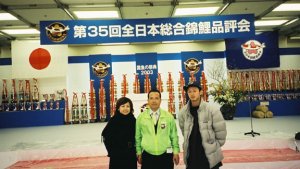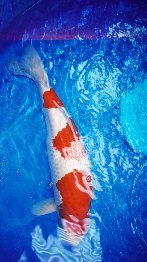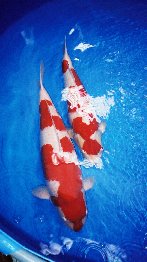










|
35 TH ALL JAPAN SOUGOU NISHIKIKOI HINPYOUKAI
(35TH ALL JAPAN COLLECTIVE NISHIKIKOI SHOW)
MATSUNOSUKE'S COMMENT
The overall quality of the fish exhibited at the competition has noticeably gone up since last year. This is indicative of the extent of improvements in the Koi keeping techniques. As the quality goes up, those who show at the All Japan Koi Show, face stiffer competition than ever before.
 A total of 3179 fish had participated in the 35th All Japan Collective Show. Among which, there were 19 in the “Shubetsu” category, the Japan Number One Award for each of the categories.
A total of 3179 fish had participated in the 35th All Japan Collective Show. Among which, there were 19 in the “Shubetsu” category, the Japan Number One Award for each of the categories.
This year, a new addition to the show was a new award category called "Sakurashou (Cherry blossom award)". Sakurashou was formed by the Shinkou Kai to recognize superior Koi in the categories other than the four main categories; such as Kohaku, Sanke, Showa, and Shiroutsuri. Through this new award category, Shinkou Kai hopes to award the superior Koi from secondary varieties and give them more recognition in the future.
 The other new addition was the new category in the "Taigyo no bu", which is the category of large fish in size range about 75cm ~ 80cm.
The other new addition was the new category in the "Taigyo no bu", which is the category of large fish in size range about 75cm ~ 80cm.
Of all the show the fish that stayed in my mind the most, was the Ginrin Showa- it was impressive. Until now, no one has been able to show such a large Ginrin Showa. This particular Ginrin Showa was not only large in size, but also very high quality. It belonged to an amateur hobbyist and I was quite impressed by this Ginrin Showa.
Our involvement in the 35th All Japan Collective Nishiki Koi Show was such that there were about 50 Koi that entered the Show from Isawa Nishikikoi Center. These were generally stocked in Isawa, and their condition were fine-tuned for about one week before the show. They were then given to the dealers to enter the show.
Some of the fish from Isawa that have received awards at the show are the Japan Number One Champion Koromo in the Koromo category, Number One Ginrin Sanke, Number One Goshiki and some other categories. Ginrin Sanke is owned by Kato San, with whom many of the foreign hobbyists are familiar. Number One Male Showa, that won the prize was purchased from an amateur hobbyist. It will be actively used for this year’s spawning as a male parent Koi. It has a promising body type, which is expected to grow well and big.
 At the show it was also apparent that many of the fish were suffering from “Hada Are”, rough skin caused by fatigue due to long hours of transportation. This condition can be easily detected in the white skin of the fish. Those that suffer from “Hada Are” exhibit ed veins in the white skin, and at the same time the shine of the skin is lost.
At the show it was also apparent that many of the fish were suffering from “Hada Are”, rough skin caused by fatigue due to long hours of transportation. This condition can be easily detected in the white skin of the fish. Those that suffer from “Hada Are” exhibit ed veins in the white skin, and at the same time the shine of the skin is lost.
The Grand Champion was deserving; only a 7- ballot difference between the Grand Champion and the runner-up. As everybody knows the Grand Champion was from the Sakai Yogyojo in Hiroshima. This Grand Champion Kohaku had won the second-place during the Grand Championship in 2002. A year made a difference: it was more finished and completion was much better than last year’s.
 The runner-up was a Kohaku shown by Okayama San. This Kohaku came from Matsunosuke Sanke and Kohaku parents. It was transported from Nagano prefecture and due to the snowy road conditions its arrival was delayed and seriously affected its condition. Okayama San’s 5-year-ol Kohaku was growing well, it was 92cm in length. But its completion was not totally finalized; especially its skin condition had a blood-shot appearance due to the difficulties in transporting it.
The runner-up was a Kohaku shown by Okayama San. This Kohaku came from Matsunosuke Sanke and Kohaku parents. It was transported from Nagano prefecture and due to the snowy road conditions its arrival was delayed and seriously affected its condition. Okayama San’s 5-year-ol Kohaku was growing well, it was 92cm in length. But its completion was not totally finalized; especially its skin condition had a blood-shot appearance due to the difficulties in transporting it.
Overall, it is encouraging that each year the quality of the fish goes up as the skills of the Koi keepers improve. As for Isawa Nishikikoi Center we are excited about the new challenges that we face and are hopeful for the future competitions. Apart from Matsunosuke Sanke that we are known for, we are very confident about our Aigoromo and Goshiki for which we receive Japan Number One Award each year.
|
|

